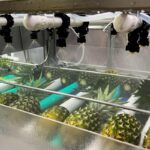Pineapples can be used for alternative energy, new research finds

In the search to give food waste in the fresh fruit industry a new life, researchers at the University of Colombia have found that pineapple skin can be used as a source of electric, thermal and bio-combustible energy.
According to lead researcher Rosa Natalia Carmona Pardo - masters student in environmental engineering - pineapple skin could be a viable alternative for energy. After recognizing the massive problem that the fruit and vegetable industry has with organic waste, the research team said it used this as a "point of departure" for its work.
Since about "60% of organic waste comes from the left-overs of fruits and vegetables", it's a "huge issue", according to Carmona. In response, the team's experiments found that the chemical makeup of pineapples is useful to generate needed energy in a way that minimizes environmental impact.
In an interview with FreshFruitPortal.com, she said that the research that led to these findings was "initially centered in finding the potential energy in potatoes, pineapples and bananas,". These products were chosen because their resulting waste product is able to reach a certain heating point that is within a range that scientists could use to measure their behavior.
Processing pineapple skins with thermo-chemical tests
Carmona then explained that the team "used thermochemical processing (pyrolysis) to characterize the energy potential with both quantitative and qualitative information." What this involved was a set of experiments with pyrolysis which allowed researchers to "understand the kind of gases that are emitted" in the process and observe the resulting behavior of the product.
Basically, they observed to see what chemical and thermal changes happened to the products' skin. Then, "with those quantitative observations, we could see the energy released by this activation, which also told us how much energy is required to take out potentially volatile compounds in the products," explained Carmona.
Researchers could then tell exactly which fruit or veggie skin was going to be most efficient for energy production. This finding is not insignificant for the fruit industry, Carmona suggests.
"So, now the industry can implement this pyrolysis process and take advantage of the residue produced by tons and tons of fruits and vegetables," she argued.
The industry can apply this to larger contexts as well, she explained. Initiatives like this show that we can live in a society that "teaches us to separate our waste and make use of it in the form of new energy, revitalizing something to give ourselves a better quality of life,".








































